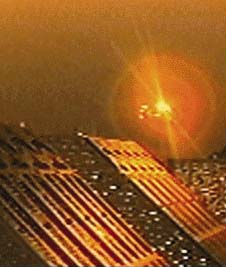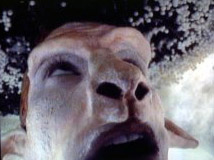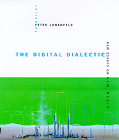Permanent Present*
As we approach the manufactured milestone of the millennium, our visual culture remains trapped in a relentless present, idly circling itself as if waiting for inspiration it doesn't expect to come. For good or ill, the high-modern period offered a succession of startling visions of what was to come; indeed, the future of the future seemed assured precisely because the scenarios themselves were so heterogeneous. Nikolai Foregger's "machine dances," concocted in the heat of Soviet revolutionary idealism, and Le Corbusier's slick materials fetish of the 1930s both extolled the glories of the industrial, though to radically different effect; Flash Gordon's pulp imaginary on Planet Mongo battled it out with the corporatized moonscape in Stanley Kubrick's 2001; Futurama at the 1939 World's Fair presaged, but remained distinct from, the googie diners and gas stations of Southern California's atomic age; Hugh Hefner's space-age Playboy bachelor pads emerged during the same period as their virtual antithesis, the eco-topian fantasies of the hippies and greens.
If, from the turn of the century through the 1960s, futures were mapped out, painted, printed, filmed, animated, and even occasionally built, today, the fever for what is yet to be has perceptibly cooled. There are reasons for this, of course: a disappointment that the present has not lived up to the past's hopes for it; perhaps an exasperation with the century's proliferation of options and brutal pace of change. That having been said, I lay the blame for our inability to imagine anything beyond the moment on two, almost perfect visual systems, both more than a decade old. The first is a movie; the second, an interface.
Consider the problem of Ridley Scott's Blade Runner (1982). With its skyscraper corridors, glaring red neon, and mix of 1940s padded shoulders and Japanese high-tech gloss, Blade Runner's aesthetic--described by Syd Mead, the visual futurist for the film, as "a maze of mechanical detail overlaid onto barely recognizable architecture producing an encrusted combination of style which we ... labeled 'retro-deco'"--is perfectly postmodern. As such, it has inoculated every cinematic depiction of the future to emerge since. When Robert Longo bought the rights for "Johnny Mnemonic," William Gibson's seminal 1981 cyberpunk short story, no
one was expecting mastery, but Longo's 1995 film was a textbook case of Blade Runner blindness: the only thing it did was make you wish you were watching the director's cut of Scott's opus. Just as the Ring cycle virtually destroyed grand opera after Wagner, Blade Runner is so gesamt, so complete in its conception, execution and integration, that other filmmakers have either eschewed competing or failed miserably in the attempt.
Paradoxically, Blade Runner truncated the possibilities for cinematic visions of the future at the very moment that science fiction became the dominant genre in Hollywood. Ever since George Lucas proved unenthusiastic industry executives wrong with the Star Wars trilogy (1977-1983), SF has dominated the international box office, with massive hits like Terminator 2: Judgment Day (1991), Jurassic Park (1993) and Independence Day (1996). Yet for all its commercial success, the SF boom has been anti-visionary: the future is now combined with then, plus new weapons and ever freakier aliens.
During the period of SF's ascendancy, much was made of the importance of digital technologies to the genre's success. But what these tools made possible was a digital realism so total that rather than expand the palette of choices, it paradoxically shut them down. (And what of digital surrealism? Its possibilities have yet to be imagined.) Which leads us to sticking point number two: the computer interface that we all know and love/hate. While there are still a few command line systems left in use (think back to the blinking green on black screens and the ubiquitous C:// prompt), the market is dominated by one particular flavor of graphical user interface, or GUI, as it's called. This is the desktop metaphor of nested
files, icons, trash cans, and cascading windows. Masterminded in the '60s, and perfected for the personal computer at Xerox PARC in the '70s, it has become the definitive human/computer interface since Apple introduced the Macintosh operating system in '84 and Microsoft rode it to hegemony with Windows through the '90s. For all its success, this interface model, like Blade Runner, has become an impediment to thinking beyond the present.
While there are regular software upgrades that incrementally increase design efficiency, nothing radically different has penetrated the computer market, nothing that really screams, "This is the future, pay attention."
If Blade Runner stymied innovation by inspiring aesthetic terror in makers, the very notion of transcending the Windows interface inspires horror in users. Techno-anxiety is the justifiable fear of novelty, and of integrating the new into one's life, especially when that new involves what is for most people the technological unknown. The preference for the comfortable if back-assed wins out over elegance of interaction or metaphorical brilliance every time. This phobic avoidance of new tools, then, has naturalized one type of interface in the very infancy of electronic information design.
These days, even the people we pay to construct visions of the future have abdicated their responsibilities. Even the plucky Disney imagineers -- who claim to forge architecture, technology and entertainment (the Alberichs of scripted spaces, to return to Wagner) -- have lost the will. When they designed Disneyland Paris in the '80s, their Tomorrowland was constructed not from the stuff of their own researches and fantasies, but instead around the future as imagined by nineteenth-century visionary Jules Verne. Perhaps Disney ought to have thought about recruiting Matthew Barney, whose Cremaster 4 (1994) is the only thing I've seen this decade to offer a credible vision of otherness, if not the future per se. Shot on the
Isle of Man, it features a local zoological anomaly with one horn pointing up and the other down, known as the Loughton ram; free-floating testicles; androgynous, body-building fairies in high heels; and Barney himself as the anti-heroic "Loughton Candidate" in a white suit, spats, and prosthetic facial makeup. Cremaster 4 fabricates its own weird cosmogony, neither
science fiction nor realism, one oozing with meaning and dripping with metaphor. It offers a way out of our permanent present because it enfolds the biological and the genetic, which will be to the twenty-first century what the mechanical and the cybernetic were to this one.
["Permanent Present" first appeared in "art/text", 63, November 1998-January 1999. Peter Lunenfeld recently edited "The Digital Dialectic: New Essays on New Media", MIT Press, 1999]]
Torna a: EXTENDED PLAY


